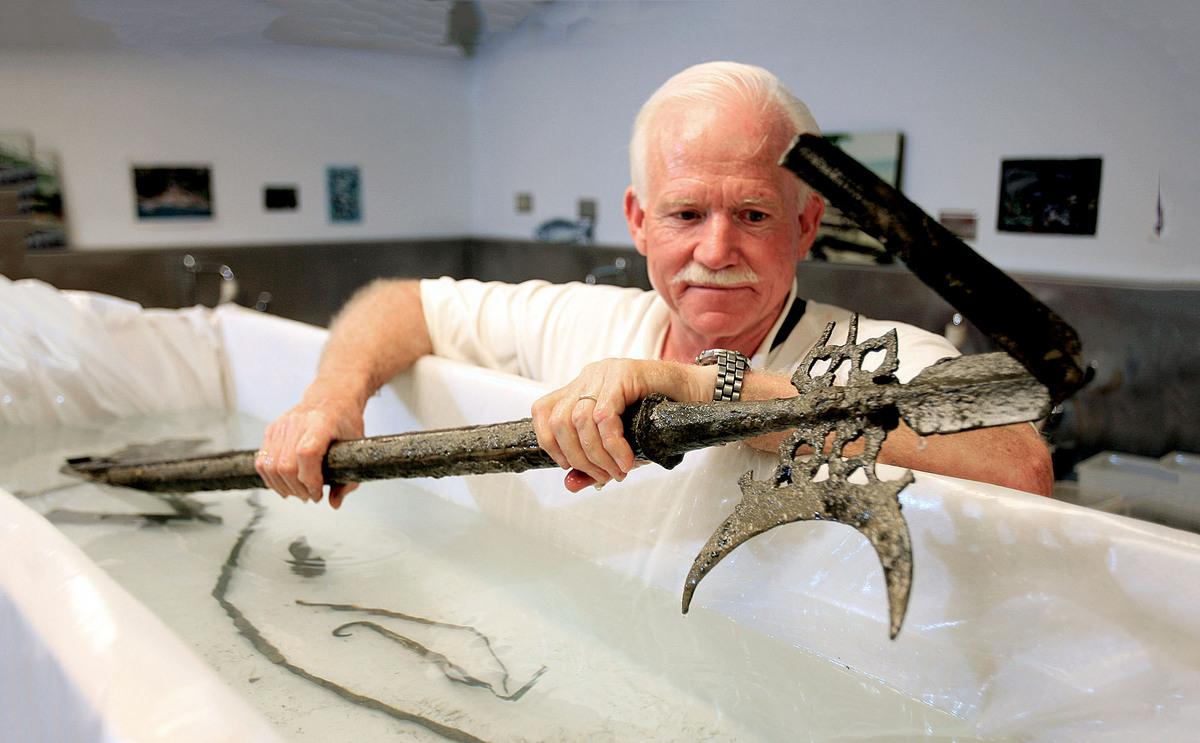Colonial Jamestown archeologist to dispel myths in Madison lecture

William Kelso, director of research and interpretation at Jamestown Rediscovery, examines a halberd — a pole weapon used by colonist soldiers — among the more than 1.7 million artifacts recovered from the Jamestown site.
Photo courtesy of Jamestown Rediscovery
There are so many common myths about Jamestown — the first permanent English colony in North America — William Kelso keeps a list handy.
They say the colony, established in 1607, failed; that the greedy Virginia Company sent unqualified, undersupplied colonists; that the Jamestown Island site, in present-day Virginia, was a terrible choice, surrounded by exclusively violent natives.
And the big one: the fort the colonists built was washed away by the James River, maybe centuries ago, guaranteeing a long-term mystery.
“We’ve got 1,727,000 artifacts — pottery, coins, armor, arms — now that tell a different story,” says archeologist William Kelso, director of research and interpretation at the Jamestown Rediscovery Project and leader of the effort that located the site of James Fort (high and dry) in 1994.
Kelso will be in Madison Tuesday, Oct. 1, to tell the story of Jamestown and the rediscovery process in a free, public talk, “Jamestown: The Buried Truth,” at 7 p.m. in the auditorium at the Wisconsin Historical Society, 816 State St.
“I believed the myths, too, but the victors write history,” Kelso says. “Most of the histories of Jamestown were written in the late 19th century by northern historians after the Civil War, based on records and stories. There was no physical evidence of that time period until we came along.”
That was nearly 20 years ago. But Kelso took an interest in Jamestown before that, as a student at the College of William and Mary in Williamsburg, Va.
“I saw a date of 1607 and thought, ‘That’s even earlier than the pilgrims,’ so I had to see it,” Kelso says. “And I wanted to visit that fort.”
But when he finally did make it to the Jamestown site, a guide on the island told him the fort had been lost to the shifting James River.
“I said, ‘Well, this place is all overgrown with trees. Could it be here?'” Kelso says. “That stuck with me, and after many years of asking, the owner of the wooded part of the island told us we could try.”
In the interim, Kelso went on expeditions around the world, including excavations under and around churches in Israel.
“We started looking between the Jamestown Island church and the river, and sure enough, we found the footprint of the fort,” Kelso said.
The artifacts they have recovered reveal a group of colonists undoubtedly tested by their new surroundings, but working hard at making iron, associating peacefully with local Native Americans and establishing a new life for themselves.
But occasionally — during a period of particular hardship known as the “Starving Time” — eating one another.
That was the winter of 1609 and 1610, when a drought and failed crops, and a conflict with some of the Powhatan Indians, combined with seven ships full of hundreds of hungry new arrivals.
“It was just bad luck,” Kelso says. “And they got to a point where some — not many; we’re not sure how many — did resort to cannibalism.”
In May, Kelso and his staff announced a confirmed case of cannibalism, a young English woman whose remains were found in the basement of a building. Her bones, which were marked by the tools used after her death in crude butchering, were piled among animal carcasses and other food waste.
The Jamestown Rediscovery group has identified more than 100 graves, a list of discoveries that make Kelso interested in the work being done by UW–Madison’s Molecular Archaeology Group, coordinated by classics Professor William Aylward.
“I’m a historian, so I’m a little apprehensive about going in with the scientists,” Kelso says, “but I think they can help us solve some of our problems.”
A biological science approach can help Jamestown Rediscovery identify the cause of death — or contributing causes, such as malnutrition or illness — from the remains of the colonists. And techniques in use at UW–Madison may help identify the colonists themselves.
“We have a very popular exhibit of a skeleton that we believe is Capt. Bartholomew Gosnold, who was really the mastermind of the colony, but we’re not certain,” Kelso says. “We were able to get mitochondrial DNA from that skeleton, but that is passed from a mother to a son, down female lines.”
Finding a female relative of Gosnold’s has proven daunting. But the UW–Madison researchers deal with nuclear DNA, a different type of the DNA molecule, which opens up the opportunities for comparison.
“I’ll be talking with scientists in Madison about what our collection contains, and what those artifacts may mean to them if they apply the scientific techniques they know,” Kelso says.
The more we know about Jamestown, the better we may understand ourselves. The colonists were dealing with plenty of issues that are still at the forefront of American life.
“It’s where representative government started among colonists,” Kelso says. “They were holding trials by jury within two or three months of landing. There were Africans — the first in North America — holding social status similar to many of the Europeans.”
Any new information about life on or around Jamestown Island would help illuminate a period in North American and United States history that gets short shrift, according to the archeologist.
“You get the turkey and pilgrims. That’s reinforced every year,” he says. “But Jamestown is an unsung beginning of America, part of our origin that doesn’t get told often.”
